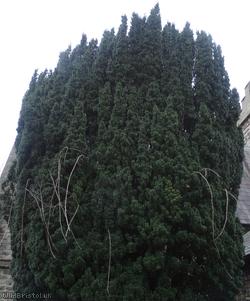Irish Yew - Taxus baccata 'Fastigiata'
Favourite Photos
| image | species | author | location | uploaded | taken | select |
|---|---|---|---|---|---|---|
 |
Irish Yew - Taxus baccata 'Fastigiata' | dylan | Horfield Parish Churchyard | 9 Apr 2021, 12:57 p.m. | 8 Apr 2021, 6:32 p.m. |
Species Description
Widespread throughout the UK as cultivated. Habitat includes: gardens, parks, allotments, cemeteries / churchyards. It is a fastigiate (upright branches which are parallel to the main stem) cultivar of the Yew (t. baccata) selected from two trees found growing in Ireland, and the several cultivars with yellow leaves, collectively known as "golden yew". Height: Up to 9 m. Width: Up to 2.4 m.
In 1767 a local farmer named George Willis, retrieved a pair of unusual looking yew seedlings from the slopes of Cuilcagh mountain in the Aghatirourke townland, Florence court (County Fermanagh). One of the two specimens was presented to, Lord Mount Florence (landlord and later 1st Earl of Enniskillen) who had it planted in Florence Court estate old garden then to become the 'Florence Court Yew'. The other was planted in George Willis' own garden, which died in 1865. The strange, upright characteristics survived into maturity and the tree attracted interest from visitors and horticulturists. As the species is dioecious and both specimens were Female, all Irish Yews today are clones of the two original trees but most of them are from the Florence Court Yew. Specimens raised from seed (cross between Yew and Irish Yew) revert back to the normal Yew (t. baccata) and they lose the Irish yew's distinctive upright habit. They can however display some variations in foliage colour.
Cuttings for propagation were taken from the tree and by 1820 the strange Yew had become so popular that the tree was commercially reproduced. It is believed almost all specimens are descended from the remanding tree at Florence Court. Today, as a result of the volume of cuttings taken from the tree and shading from larger Ash and Sycamore trees surrounding it, the Florence Court Yew has lost much its characteristic shape and balance of its species.